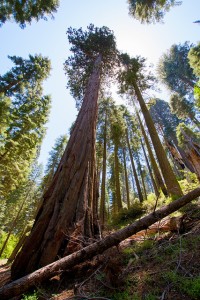
In the United States, the 1930s was far from a time of plenty. Through the Great Depression, Americans witnessed a razing of the financial system that, on the heels of the prosperous 1920s, seemed nearly incomprehensible. A time of hunger, homelessness, and desperation, the Great Depression sticks in our national consciousness as a reminder of just how difficult and dark life can become after an unexpected hardship. The triumphs of the decade (though admittedly few) are left obscured by the misfortune of millions. And yet, this solemn era did produce some scientific legacies worth remembering…
It was in graduate school that Marianne first became interested in climate change. When she went to her advisor, Dr. Reynolds, to discuss thesis topics, he told her about a very old dataset on forest composition maintained by a colleague at another university. Though the data collection began during the Great Depression, it was still ongoing over 80 years later. Dr. Reynolds mentioned the dataset included valuable information on tree size measurements. When Marianne realized this could prove useful in a project on carbon storage, she was hooked. Her advisor emailed his contact at the other university, who was happy to share the dataset with someone who would put it to good use.
Marianne’s interest was really piqued when she began going through the data and learning about the study’s history and purpose, both of which proved even richer than she had anticipated. The data was officially collected to document tree growth as a guide for timber harvesting in the area. But the forests surveyed were located on steep and rocky ground – certainly not ideal for logging. The Civilian Conservation Corps, which had organized the project, had a motive more pressing than impractical logging prospects: increasing national employment. By hiring men who were out of work to walk the forests and measure the trees found there, the CCC was able to provide living wages for the victims of the Great Depression. The men involved likely viewed counting trees and measuring their diameters as busy work, but they were undoubtedly pleased to be earning some money for themselves and their families.
After the country recovered, data collection still continued for a few years. But once the economy healed, job creation was no longer a national priority. And there was little justification for continued forest monitoring when the timber was unlikely to ever be harvested. So the land was sold to a local college, and the dataset along with it. Conscious of its important historical ties and the years of effort behind it, the institution decided to continue the data collection. Undergraduate students were hired to carry on the work started by the CCC. This way, the dataset was maintained and students received valuable training in data collection. When technology became available, students worked to digitize the forest data and preserve it for the future.
Many years later, as Marianne sorted through the data, she began to notice something strange. When she had received the dataset, Marianne was warned by the university that it might contain some recording errors. As she began combing through the figures, Marianne was on high alert for anything unusual. So she was unsurprised when some of the more recent data didn’t look quite right; the numbers showed that trees of particular species and size would be present one year and then gone the next, only to return in the data the following year as though nothing had happened. A sizeable oak tree would disappear without a trace, and then be mysteriously replaced by a maple tree of similar dimensions.
Marianne was no arborist, but she did know that trees of that size did not sprout overnight. She suspected that perhaps the students had been a little less careful in their data collection. But Marianne could hardly fault them – there were over 15 species of trees intermixed in the forest, and proper identification could certainly prove challenging for a student new on the job. These human errors required a little detective work on Marianne’s part to fill in the gaps. She divided her task by surveying the dataset one year at a time. Piece by piece, she scrutinized the measurements and species names, pausing at any detail that did not seem to fit. When she encountered errors, Marianne made an educated guess about whether a tree had been misidentified or left out during the recording process. In the case of more recent discrepancies, Marianne was actually able to visit the forest herself, find the tree in question, and revise the data as necessary.
Before using the data in her analysis, she was careful to rigorously check for errors and assure that the tree counts added up. However, dealing with minor mistakes was a small price to pay for continued data collection. The quality control that Marianne undertook may have been a little more time consuming, but it was worth the assurance of consistent data. To keep track of her changes, Marianne maintained two datasets – the original, and her corrected version.
Using the long-sustained dataset, Marianne was able to complete a thoughtful thesis on forest succession and fluctuating rates of carbon sequestration – something that would have been impossible without constant and diligent data collection, preservation, and curation throughout the decades.
But in some ways, this encouraging story represents for Marianne a missed opportunity. After all of the time she devoted to quality control and assurance, Marianne never shared the corrected dataset with the university. The communication that existed between them had never been very strong; Marianne, still believing herself to be an inexperienced graduate student, had not realized what value the assured dataset might bring to the university, and the university had never thought to ask for it.
